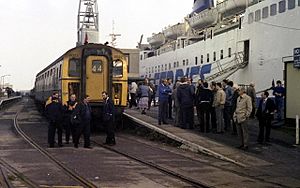British Rail Class 438 facts for kids
Quick facts for kids British Rail Class 438 (4-TC) |
|
|---|---|

Class 438 unit at Weymouth Quay
|
|
| In service | 1966–1988 |
| Manufacturer | BR/BREL York |
| Family name | BR Mark 1 EMU |
| Number built | 34 sets, 1 spare DTSO |
| Formation | 4 car sets - DTSO-TFK-TBSK-DTSO |
| Fleet numbers | 401–434, later 8001–8034 |
| Capacity | 42 First, 160 Standard |
| Operator(s) | British Rail |
| Depot(s) | Bournemouth TMD |
| Specifications | |
| Car length | DTSO: 19.70 m (64 ft 8 in) TFK/TBSK: 19.65 m (64 ft 6 in) |
| Width | 2.82 m (9 ft 3 in) |
| Maximum speed | 90 miles per hour (145 km/h) |
| Weight | DTSO: 32.5 tonnes (32.0 long tons; 35.8 short tons) TFK: 35.4 tonnes (34.8 long tons; 39.0 short tons) TBSK: 33.6 tonnes (33.1 long tons; 37.0 short tons) Total: 134 tonnes (132 long tons; 148 short tons) |
| Train heating | Electric train heating |
| Bogies | B5 |
| Braking system(s) | Air (EP/Auto) |
| Safety system(s) | AWS |
| Track gauge | 1,435 mm (4 ft 8 1⁄2 in) |
Imagine a train that could be pushed or pulled by a separate engine! That's what the British Rail 4-TC units were like. These were special train sets made up of four carriages. They didn't have their own engines. Instead, they had a driver's cab at each end. This meant a separate locomotive could attach to either end. It could then push or pull the 4-TC unit along the tracks.
These units were created by British Rail at their York Works. They were built in 1966-1967 and again in 1974. They were made by changing existing Mark 1 train carriages. The idea came from an earlier test unit called the 6TC. The 4-TC units were very flexible. They could be used on many different railway lines.
Contents
What is a 4-TC Unit?
The "4-TC" name tells you a lot about these trains. The "4" means there were four carriages in each set. The "TC" stands for "Trailer Control." This means the carriages were trailers. They didn't have engines themselves. But they had controls for the driver. This allowed the driver to control the locomotive attached to the set.
How They Were Used
These units were often used with special electric locomotives. These were called Class 73 or Class 74 engines. The 4-TC units were popular on lines that had both electric and non-electric sections. For example, a Class 73 engine could pull the 4-TC on electric lines. Then, it could switch to its diesel engine for non-electric parts. This made travel smoother. Passengers didn't have to change trains.
They were mainly used on routes in the south of England. A very famous route was the line to Weymouth Quay. This line had a special section that ran along the street! The 4-TC units were perfect for this. They could be pushed by a locomotive. This made it easier to navigate the tight curves and street running.
A Changing Identity: Their Class Numbers
Over their working lives, these train sets had a few different names. When they were first built, they were called Class 442. Their numbers were in the 300 and 400 series.
Later, their classification changed to Class 491. They kept this name for most of their time in service. Just before they were taken out of service, they got one last name change. They became Class 438. At this point, their numbers also changed. They were renumbered from 8001 to 8034.
Images for kids






